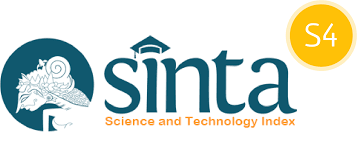Dampak Pemanasan Global terhadap Fenologi Tanaman Kecipir (Psopocarpus tetragonolobus) dan Hubungannya dengan Serangga Pollinator
Abstract
Global warming or often referred to as global warming is a form of imbalance of ecosystems on earth due to the process of increasing the average temperature of the atmosphere, sea, and land on earth. The impact of global warming can make agricultural plants flower faster while pollinating insects are not ready so that the reproductive cycle is disrupted. Studying temperature changes as a result of global warming on an organism can be represented by an altitude gradient. The study aims to determine the effect of temperature changes on the phenology of winged bean plants (Psophocarpus tetragonolobus) which is described by the gradient of altitude and to determine the diversity of pollinator insects. The independent variable in this study is the difference in the gradient in elevation of the place, while the dependent variable is the phenology of the development of winged bean flowers and pollinator insects. The results of the study of abiotic factors showed that air temperature and sunlight intensity decreased in line with the increase in altitude from the surface of the seawater, while the humidity increased. The phenological analysis of winged bean plants showed the influence of altitude on plant height, number of leaves and branches, time of the first appearance, number of flowers and flower size as well as the diversity of pollinator insects.
References
Grimstad, S.O. 1993. The effect of a daily low temperature pulse on growth and development of greenhouse cucumber and tomato plants during propagation. Scientia Horticulturae, 53: 53 – 62.
Hidayat, Y. 2010. Perkembangan Bunga dan Kuntum pada Tegakan Benih Surian (Toona sinensis Roem). J Agrikultural, 21 (1): 13-20.
Klein, A. Dewenter, I.S., & Tsharntke T. 2003. Bee pollination & fruit set of coffea arabica & C. Canephora (Rubiaceae). American Journal of Botany, 90: 153-157.
Koti S, Reddy, K.R., Reddy, V.R., Kakani, V.G., & Zhao, D. 2005. Interactive effects of carbonedioxide, temperature, and ultraviolet-B radiation on soybean (Glycine max L.) flower and pollen morphology, pollen production, germination, and tube lengths. J. Exp. Botany, 56:725-736.
Memmott, J., Craze, P.G., Waser, N.M. & Price, M. 2007. Global warming and temporal variability in phenology in response to climate change. Glob. Ecol. Biogeogr., 15: 498-504.
Menzel. A., Sparks, T.H., Estrella, N. & Roy, D.B. 2006. Altered geographic and temporal variability in phenology in response to climate change. Glob. Ecol. Biogeogr., 15:498-505.
Michael P. 1995. Metode Ekologi Untuk Penyelidikan Lapangan dan Laboratorium. Terjemahan Yanti R. Koester. UI-Press, Jakarta.
Nayyar, H., Bains, T.S., Kumar, S., & Kaur, G., 2005b. Chilling effect during seed filling on accumulation of seed reserves and yield of chickpea. J. Sci. Food Agric., 85:1925–1930.
Parma. 2010. Pengaruh Intensitas Cahaya Terhadap Produksi Umbi Tanaman Lobak (Raphanus sativus L). Jurnal Buletin Anatomi dan Fisiologi, 18 (2): 29-38.
Parmesan, C. & Yohe, G. 2003. A global Coherent Fingerprint of Climate Change Impacts Across Natural System. Nature, 21: 37 42.
Rafiatul, D. 2019. Pengaruh Ketinggian Tempat terhadap Pertumbuhan, Hasil dan Kandungan Steviol Glikosida pada Tanaman Stevia (Stevia rebaudiana). Vegetalika, 8(1): 1-12.
Raharjeng, A. 2015. Pengaruh Faktor Abiotik Terhadap Hubungan Kekerabatan Tanaman (Sansevieria trifasciata L). Jurnal Biota, (1): 33-41.
Thakur, P., Kumara, S., Malik, J.A., Berger, J.D., & Nayyar, H. 2010. Cold stress effects on reproductive development in grain crops: An overview. Environmental and Experimental Botany, (67): 429–443.
Visser, M.E. &Both, C. 2005. Shifts in phenology due to global climate change: the need for a yardstick. Proc. R. Soc., B.272: 2561–2569.
Walther, G.R., Post, E. Convey, P., Menzel, A., Parmesan, C. Dan Beebee, T.J.C. 2002. Ecological responses to recent climate change. Nature, 416: 389-395.
Widhiono, I dan Sudiana, E. 2015a. Keragaman Serangga Penyerbuk dan Hubunganya dengan Warna Bunga pada Tanaman Pertanian di Lereng Utara Gunung Slamet, Jawa Tengah. Biospecies. 8(2): 43-50.
Widhiono, I. Sudiana, E and Darsono, 2017. Diversity of Wild Bees along Elevational Gradient in an Agricultural Area in Central Java, Indonesia. Psyche Volume 2017, Article ID 2968414: 1-5.
Yulia, N.D. 2007. Kajian Fenologi Fase Pembungaan dan Pembuahan Paphiopedilum glaucophyllum J.J.Sm. var. Glaucophyllum. Biodiversitas. 8 (1): 58-62.
Yuliana, Soemarno, Yanuwiadi, B., & Leksono. A.S. 2015. The relationship between habitat altitude, enviromental factors and morphological characteristics of Pluchea indica, Ageratum conyzoides and Elephantopus scaber. OnLine Journal of Biological Sciences, 3: 143-151.














_copy.png)



